By: Michael Sopow and Clayton Howe

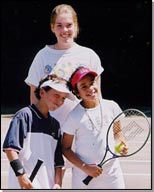


(www.tennisone.com)
(www.havergal.ca)
(www.tenniscanada.com)
TABLE OF CONTENTS



|
Tactical Problem
|
On-the-Ball-Skills
|
Off-the-Ball-Skills
|
| Consistency - Keep the ball in play - Force opposition to make mistake |
- Toss and serve - Contact point - Power and control - Effective forehand, backhand, and volley |
- Ready position - Recover/relocate to target area - Prepare early |
| Placement and Positioning - Hitting to pressing zones - Setting up opponent - Recovering and relocating to target area |
- Grips - Forehand, backhand, serve, and volley |
- Effective movement patterns, split-step, push off outside foot, staying low - Recover/relocate - Ready position |
| Spin and Power - Using spin and power to keep opponent guessing - Reduce time for opponent to prepare |
- Topspin (forehand, backhand) - Vary speeds on strokes - Vary power on serve - Flat/slice serves - Backspin on forehand, and backhand |
- Prepare early - Recover/relocate to target area |
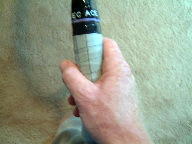
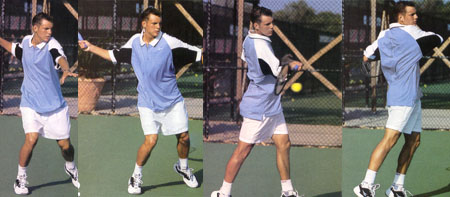









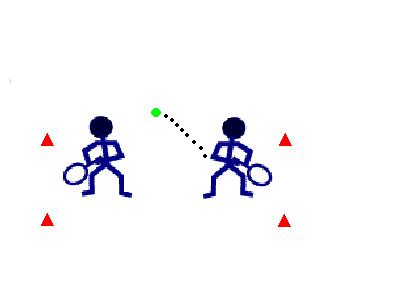

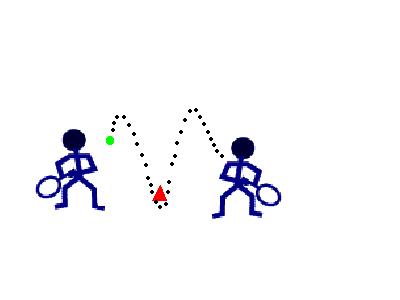








|
LESSON
|
REVIEW SKILLS/CONCEPTS
|
NEW SKILLS/CONCEPTS
|
MAJOR TEACHING POINTS
|
ORGANIZATION / TEACHING STYLES
|
| One |
1. Ready position
2. Proper movement: 3. Positioning 4. Forehand Grip |
Ready Position: - balls of feet - bend at knees - racket in front, proper grip Proper Movement: - push off outside leg - stay low Positioning: - Where do you go after you hit the ball? Forehand Grip: - shake hands with racket - 'V' shape Tactical Questions: - How can you keep the rally going? - How can you give yourself more time to make the shot? |
1. Warm-up: Line game
(Guided Discovery) 2. Keep it up game 3. Demo of grip and ready position 4. Shadow drill with partner (Practice) 5. Rally with partner: - moving to open space - creating space - efficient movement |
|
| Two |
1. Ready position, and grip 2. Positioning and movement |
1. Ball control 2. Forehand stroke |
Ball Control: - Low body position - Contact point, timing Forehand stroke: - prepare early - transfer weight - follow through, low-high |
1. Warm-up: Castle
game
(Guided Discovery) 2. Demo of forehand 3. Over space game (Practice) 4. Wall drills: hitting to self against wall, consistency (Practice) 5. Mini-game with partner (Practice) |
| Three |
1. Positioning 2. Forehand stroke |
1. Backhand grip
2. Backhand stroke |
Backhand grip: - from forehand grip slide hand over so 2nd thumb knuckle is on 6th bevel Backhand stroke: - racket side to net - transfer weight - follow through, out, across, and up |
1. Warm-up: Triangle
beanbag game (Reciprocal) 2. Demo of backhand grip and stroke 3. Backhand brush progression (Practice) 4. Rally with partner (Practice) 5. King/Queen of Court |
| Four |
1. Ground strokes |
1. Serve
|
1. Serve: - side stance - toss - la, de, da - reach high - like baseball throw |
1. Warm-up: 2. Demo of serve 3. Serving technique (Command) 4. Serving drill (Practice 5. Mini-game with partner |
| Five |
1. Movement and positioning |
1. Game tactics / strategies 2. Bringing skills together 3. Scoring and rules |
1. Hitting to pressing zones 2. Setting opponent up 3. Winning the point 4. Assessment |
1. Warm-up: Stations - different activities at dif. levels (Inclusion) 2. 3 Ball toss (Practice) 3. Partner Rally: ask tactical questions that lead them to develop a singles strategy (Guided discovery) 4. Group Tournament |
| Six |
1. Serve |
1. Overhead smash
|
1. Overhead smash: - similar to serve - reach for ball - extend - hit to corner of service box |
1. Warm-up: Line tag 2. Demo of Overhead smash 3. Practice with partner, one person feeding (Reciprocal) 4. Rally with partner (Practice) 5. King/Queen of court |
| Seven |
1. Overhead smash and serve 2. Positioning and movement |
1. Volleying
|
1. Volleying: - short swings - quick, efficient movements - anticipate |
1. Warm-up: Dink game
(Guided Discovery) 2. Review of serve 3. Demo of volley 4. Volley drills (Practice) 5. Serve and Volley 6. Group Tournament |
| Eight |
1. Review skills: forehand, backhands, serve, and volleys |
1. Setting up your opponent |
1. Playing to pressing zones 2. Relocating to target area |
1. Warm-up: Lunges - In partners, one person is tossing ball, other lunges to grab it (Practice) 2. Station work: - different stations set up with criteria sheets (Self check) 3. King/Queen of court 4. Set up class tournament for next class |
| Nine |
1. Tennis etiquette |
1. Trip to Oak Bay bubble 2. Mini-Tournament |
1. Consistency 2. Game-play |
1. Partner rallying (Practice) 2. Class tournament, one court left open for practice, 3 ball toss, etc. |
| Ten |
1. Mini-Tournament 2. Performance assessment |
1. Observe from a distance, do not put students under any added pressure |
1. Warm-up: Partner rallying (Practice) 2. Class Tournament |
|
TIME
|
LESSON CONTENT
|
TEACHING POINTS AND ORGANIZATION
|
| 20 min |
Introductory activities: - Line game - Keep it up game |
- Get students into partners, number 1 and 2,
# 1's go get equipment # 2's go find a space. - Rules: ball must bounce on own side, ball must go through cones, co-operate-compete - Cues: stay low, anticipate, recover and relocate - Diagram, see above - Switch partners around - Rules: ball/shuttlecock cannot touch ground, object must go above head height, must stay in playing area - Cues: move to open space, stay low, anticipate - Diagram, see above - Pushing off outside foot, staying low, moving to target area. Tactical Questions: Where do you go after you hit the ball? How can you fool your partner? |
| 10 min |
Skill Development/Concept: - Demo of forehand grip and ready position - Shadow drills with partner |
- Make sure everyone can see demo. - Shake hands with the racket, "V" shape ( picture ) - Bend at knees, feet shoulder width apart, racket waist height in front of you - In partners, #1 leads first and #2 follows, than switch around. - Partners give feedback to each other on their moving patterns. |
| 25 min |
Culminating Activity: - Rally with Partner |
- Use long and narrow court. - Switch up the partners. - Who ever loses, starts with an extra point next time. |
| 5 min |
Closure: Get and give feedback about today's lesson |
- How can you move more efficiently? - How can you give yourself more time to prepare for a shot? |
| Evaluation: |
- Where your outcomes met? - Did the students enjoy themselves? - How can you improve the lesson? |
|
TIME
|
LESSON CONTENT
|
TEACHING POINTS AND ORGANIZATION
|
| 10 min |
Introductory activities: - Castle Game |
- Get students into partners, number 1 and 2,
# 1's go get equipment # 2's go find a space - Rules: ball must bounce once before you hit it, ball must be hit above head height, and alternate hits with partner - Cues: bend at knees, stay low move into target area - Diagram: see above - Tactical Questions: How can you give your partner more time? Where do you go after you hit the ball? - Have various balls and other equipment (rackets, paddles, etc.) to suit all ability levels |
| 25 min |
Skill Development/Concept: - Demo of forehand - Over space game - Wall Drills |
- Make sure everyone can see demo - Switch partners for over space game (#1's stay where you are, #2's go get equipment and find a new #1) - Show students how to set up court (see above ) - Rules: must hit above head height, keep ball into play, ball must be hit over area - Cues: recover and relocate, stay low, anticipate - Everyone finds a space near the wall - Hit forehands working on consistency, (How many times can you keep it going? ) |
| 20 min |
Culminating Game: - Mini-game with partner |
- Switch up the partners again - Play on a long and narrow court - First to win 3 games, than find new partner |
| 5 min |
Closure: Questions |
- How can you keep the rally going? - How can you give yourself more time to play the ball? - How can you improve you consistency? |
| Evaluation: |
- Time on task - Were your outcomes met? - Did the students achieve the learning outcomes for the lesson? If not, why? - How can you improve the lesson? |
|
Forehand
|
Backhand
|
Forehand Volley
|
Backhand Volley
|
|
| Down the line with partner tossing the ball. (5
in a row) |
||||
| Cross Court with partner tossing the ball. (5 in
a row) |
||||
| Rally with partner to deep third of the court continuously
for 10 shots. |
||||
| Rally with partner hitting ball to deep corner’s
continuously for 10 shots. |